Andrew Jackson
 Andrew Jackson (1767-1837) - Born 15 Mar 1767 near the unmarked border between North and South Carolina. Served in the War of 1812, the First Seminole War, as military governor of Florida, as the first United States Representative from Tennessee, as U.S. Senator from Tennessee and two terms as President of the United States from 4 Mar 1829 to 4 Mar 1837. Died 8 Jun 1845 in Nashville, Tennessee. Early YearsJackson was born on 15 Mar 1767. His parents were Andrew Jackson and Elizabeth Hutchinson, emigrants from Ireland who brought their two children with them. Jackson's father died in Feb 1767, just before Andrew was born. The actual birth site is unknown but is assumed to be somewhere along the then unmarked border between North and South Carolina. Revolutionary War (1775-1783)At age 13 during the Revolutionary War, Jackson became a courier for the local militia. Andrew and his brother Robert were captured by the British and Andrew was subjected to abuse from a British officer when he refused to polish the officer's boots. The two brothers were released but Robert soon died and his mother died during a cholera outbreak in 1781. Andrew became an orphan at age 14. Andrew had limited education and worked while studying law in Salisbury, North Carolina. In 1787, he was admitted to the bar and moved to Jonesborough, Tennessee. In 1796 Jackson was elected as the first U.S. Representative from the new State of Tennessee and the next year he was elected a U.S. Senator but he resigned after only one year in office. From 1798 to 1804 he served as a judge on the Tennessee Supreme Court and in 1801 he was appointed Colonel of the Tennessee militia and in 1802 he was elected Major General of the militia. War of 1812 (1812-1815)At the beginning of the War of 1812 the "Red Stick" Creek Indians rose up and attempted to drive settlers from their lands. At Fort Mims some 400 troops, settlers, and slaves were massacred by the Red Sticks. Jackson assembles a force of militia, U.S. regular troops, and friendly Indians. During the Creek Indian War he defeated the Red Sticks at the Battle of Horseshoe Bend in 1814 killing some 800 Red Sticks but sparing their leader William Weatherford. 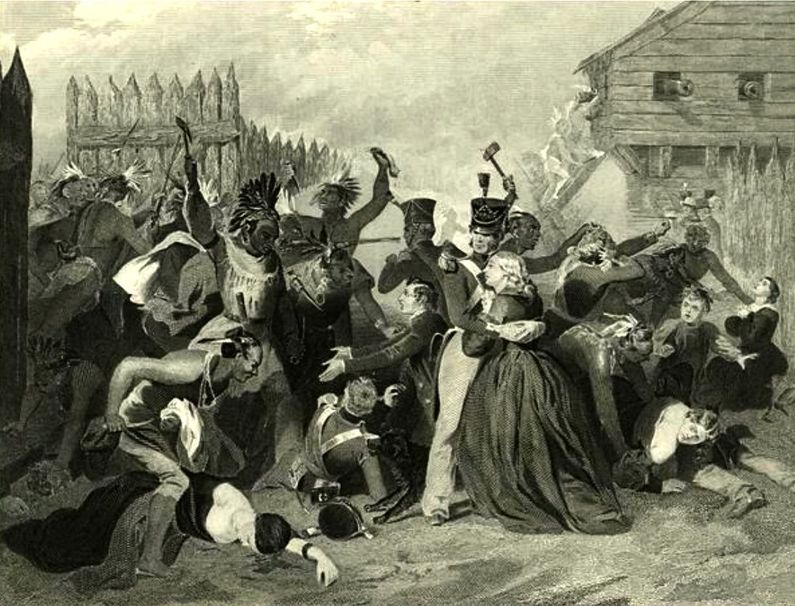
Jackson was promoted to Major General and made the military commander of the Seventh Military District. He became convinced that the only solution to the Hostile Indian problem was removal. Jackson forced the tribes, both hostile and allies to sign the Treaty of Fort Jackson, ceding their lands and the removal began. 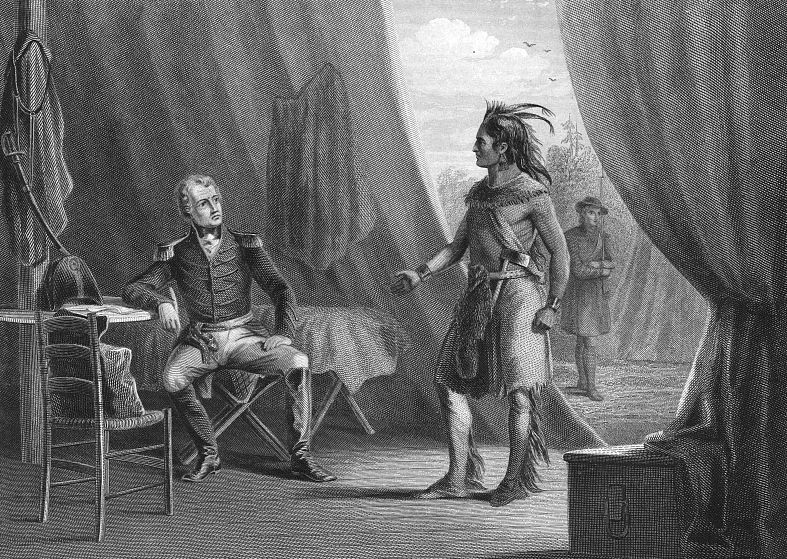
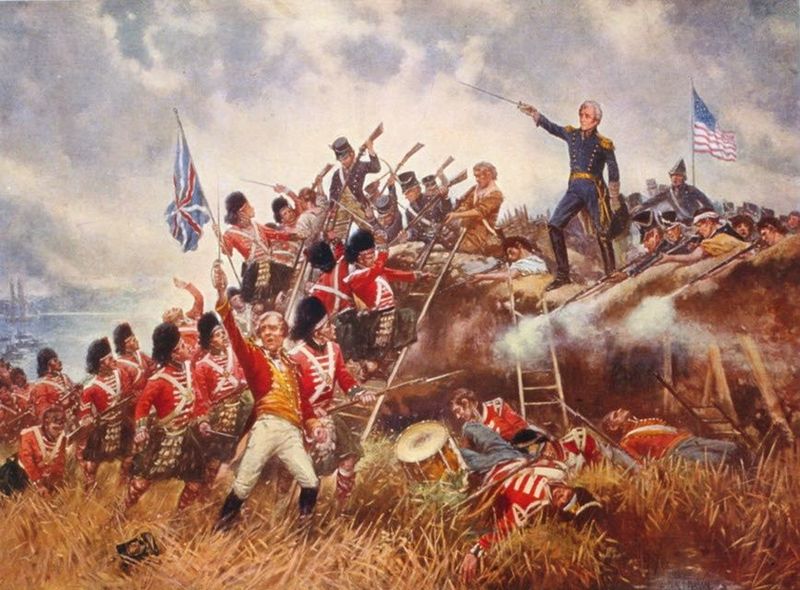
First Seminole War (1817-1818)General Jackson attacked and destroyed Negro Fort in Florida in 1816 and then attacked the Spanish at Pensacola. The British had left a fully equipped fort to 300 escaped slaves and some 30 Seminole and Choctaw Indians when they departed after the war. The fort became known as the Negro Fort and served as a gathering point for escaped slaves. The occupants of the fort fired on a passing U.S. Navy ship, killing four Americans. Jackson's forces retaliated and a shell struck the powder magazine in the fort. The resulting explosion blew up the fort and killed most of the occupants. After a series of incidents and attacks by hostile Seminoles, U.S. General Gaines attacked the perpetrators at Fowltown in November 1817, marking the start of the First Seminole War. Jackson was placed in command of the forces and ordered to invade East Florida in 1818. In his march across Florida Jackson destroyed the major Seminole and black villages, Jackson declared victory and sent the Militia and Indian allies home. Jackson went back to Pensacola, which was still in Spanish Florida, and captured the city. He removed the Spanish garrison to Cuba in 1818. The Spanish ceded the Florida colony to the United States with the Adams-Onis Treaty of 1819 (ratified in 1821). Jackson returned in 1821 to accept Spanish Florida from the last Spanish Governor. General Jackson then became the first U.S. military governor of the Florida territory in 1821. Presidential Elections (1824 and 1828)In 1822 the Tennessee Legislature nominated Jackson for President and elected him to the U.S. Senate. In the Presidential election Jackson won the popular vote and the Electoral College but with only a plurality, not a majority, and the election was thrown into the U.S. House of Representatives who chose John Quincy Adams. Jackson resigned his U.S. Senate seat in October 1825. He was again nominated for President by the Tennessee Legislature and this time he defeated John Quincy Adams easily. Jackson's wife Rachel became an issue in the election when it was discovered that she was not properly divorced from her first husband when she first married Jackson. Rachael and Andrew were wed again after her divorce was properly done in 1794. Rachael died of a heart attack on 22 Dec 1828 just weeks before Andrew was to take the oath of office. President Andrew Jackson (1829–1837)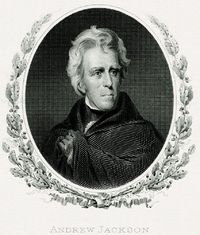 Andrew Jackson's first inauguration took place on 4 Mar 1829 on the East Portico of the incomplete United States Capitol for the first time. After the ceremony, Jackson rode his white horse up Pennsylvania Avenue to the White House. The post-inaugural reception at the White House was open to the public and even before Jackson arrived it was full. Jackson did not stay long and had to exit by a window. He spent the night in Gadsby's Hotel in Alexandria, Virginia. The people at the reception had become a drunken mob and only exited when liquor and punch were placed on the front lawn. Jackson did not attend either of the inaugural balls. Indian Removal Act (1830)The Indian Removal Act was signed into law on 28 May 1830 by President Jackson. He believed that the Act was a wise and humane policy that would save the Indians from "utter annihilation." The Act created mechanisms to negotiate treaties with the five civilized tribes in the south for their removal to federal lands in the Indian Territory (Oklahoma). The five civilized tribes were the Cherokee, Chickasaw, Choctaw, Creek, and Seminole. The tribes were offered land and payment to move. The Choctaws and the Cherokee negotiated treaties that did not go well, resulting in the Trail of Tears. The other tribes resisted and military force was used to subdue them. The conflict with the Seminoles became the Second Seminole War and it lasted well into the next presidential administration.
Second Seminole War (1835-1842)By 1834 about 3,800 Seminoles had been relocated to the Indian Territory but the Seminoles were not happy with the process or the result. They rose up under Chief Osceola and ambushed Major Francis Dade and his command in what became the Dade Massacre. On the very same day, 28 Dec 1835, the Indian agent General Wiley Thompson and six others in his party were massacred outside the Fort King stockade. Thompson was shot 14 times and scalped. President Jackson vigorously prosecuted the war, sending large numbers of troops and building fortifications all over Florida. The war continued until Chief Osceola was captured under a false flag of truce and imprisoned in 1837. Osceola died in captivity in 1838 at Fort Moultrie, South Carolina. The war wound down and by 1842 some 4,400 Seminoles had surrendered and had been removed to the Indian Territory. The remaining small bands of Seminoles were allowed to remain in the south Florida swamplands. Banks & FinancesDuring both of Jackson's presidential terms, the Second Bank of the United States was an issue. Jackson was against the idea of a strong central bank and he thought that it had become corrupt and favored only the wealthy and powerful. The bank had been chartered in 1816 by President James Madison to help the economy recover from the War of 1812. Jackson opposed recharter the bank and vetoed a bill that would do that. President Jackson removed federal deposits from the bank in 1833 drastically increasing credit and speculation. Three years later, he issued the Specie Circular, an executive order that required buyers of government lands to pay in "specie" (gold or silver coins). A lack of sufficient space caused the Panic of 1837, which threw the national economy into a serious depression. Assignation AttemptOn 30 Jan 1835 Richard Lawrence, an unemployed housepainter from England attempted to shoot President Jackson as he left the Capitol Building. Lawrence aimed two pistols at the President and both misfired. Jackson reportedly attacked Lawrence with his cane. Lawrence was declared insane and was institutionalized. Later Years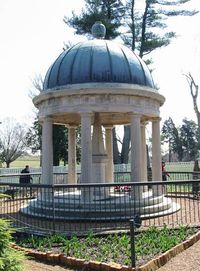 Jackson retired to his Hermitage plantation at the end of his second term in 1837. He died at the Hermitage on 8 Jun 1845 and was buried with his wife Rachael in a tomb he had designed and constructed in the Jackson Family Cemetery.
Father: Andrew Jackson (1738-1767). Mother: Elizabeth Hutchinson (17??-1781). Marriage:
Children:
Personal Description:
Sources:
|